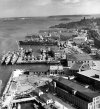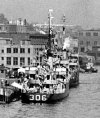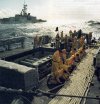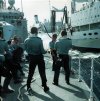
|
HMCS ALGONQUIN lies at the gun wharf in Dartmouth. This photo was taken
during July, 1945. RCN photo, Courtesy of BFC Civil. |

|
A number of the yard auxiliaries in use in April, 1945. RCN photo, Courtesy
of BFC Civil. |

|
Taken during March of 1955, this shot shows two Tribals and a Prestonian
at what is now the Navy F Jetty. The Tribal on the right seems to be HMCS
IROQUOIS. Courtesy of BFC Civil. |

|
Two Tribals on the right, and a River class destroyer on the left. The
Tribal in the middle seems not to have her guns and rangefinder installed.
Taken in 1945, this would suggest that the middle Tribal is the newly launched
MICMAC, before being fitted out. MICMAC was commissioned on Sept. 12, 1945,
so this would suggest that this picture was taken during the summer of 1945.
Looking carefully, one can see the HF/DF (High Frequency Direction Finder)
antenna at the top of the masts of the two Tribals. RCN photo, Courtesy of
BFC Civil. |

|
This is how a portion of HMC Dockyard appeared in April of 1945. The
auxiliaries from an earlier photo are at the bottom left, and the corvettes
and minesweeper from a later photo are at the top right. The pilings in the
middle of the photo are being removed to make way for a concrete piling wharf.
RCN photo, Courtesy of BFC Civil. |

|
Looking south along the Halifax shoreline, with HMC Dockyard in the
foreground. The two Tribals and the Prestonian from a picture above are visible
at the bottom left. Courtesy of BFC Civil. |

|
An enlarged portion of the above photo. In the far background can be
seen a Tribal, with the two maintenance ships, CAPE BRETON and CAPE SCOTT
tied up together. Three BANGORs can be seen, along with various other ships.
Courtesy of BFC Civil. |

|
How a portion of HMC Dockyard appeared after construction was completed,
around 1948/49. This is the wharf later used by the three carriers the RCN
operated postwar, and the Angus L. MacDonald bridge would be built over this
portion of the Dockyard some years later. The tower not far left of the crane
derrick is part of the base fire hall, where fire hoses could be hung to
drain. RCN photo, Courtesy of BFC Civil. |

|
Another view of the Dockyard taken sometime after 1948, taken at roughy
the same time as the photo above. The frigate HMCS SWANSEA (306) can be seen
in the background, with a couple tugs to the bottom left of the photo. The
floating drydocks and graving dock of the Halifax Shipyard can be seen in
the centre right of the photo. |

|
This was taken in September of 1945. The three frigates are, left to
right, ST. CATHERINES (K325), THETFORD MINES (K459), and JOLIETTE (K418).
Just visible at far right is the stern of U190, and the conning tower of U889,
which were the two U-boats captured at the end of the war. Close observation
reveals that ST. CATHERINES has a US SU Type radar, while the other two have
the British Type 271. Thus, ST. CATHERINES sports her HF/DF at the top of
her aft mast unlike the other two. RCN photo, Courtesy of BFC Civil. |

|
Taken in April of 1945, BANGOR class minesweeper INGONISH (J69) and
the corvette PICTOU (K148) and an unnamed corvette rest alongside in Halifax.
RCN photo, Courtesy of BFC Civil. |

|
Five ships tied up at what later became the Navy F Jetty in HMC Dockyard.
They appear to be four corvettes with a frigate to the right. The two ships
to the left will be CASTLE class (the outer being either COPPER CLIFF or BOWMANVILLE
with the Type 277 radar), with two Flowers in the middle. RCN photo, Courtesy
of BFC Civil. |

|
An enlargement of a portion of another photo, this is HMCS SWANSEA.
Taken in 1945, it is subsequent to the new number being added (306) but probably
prior to SWANSEA being paid off on November 2, 1945. She does not yet have
the SU tupe radar she was later fitted with, but still sports a solid dish-type
radar on the masthead. The ships ahead of her already has the SU type radar.
RCN photo, Courtesy of BFC Civil. |

|
SWANSEA again. Note the lines of flags that she wears. RCN photo, Courtesy
of BFC Civil. |

|
Another enlargement of part of another photo, these are some of the
tugs in use during 1945. The tug on the inside is one of the original GLEN
class, with two smaller yard tugs on the outside. Several of the yard craft
are on the wharf to the left of the photo. RCN photo, Courtesy of BFC Civil. |

|
This is the propeller from HMCS CAPE SCOTT, the East Coast fleet maintenance
ship, and it is now mounted in front of the Rollo Mainguy Building, MARCOM
Command, in HMC Dockyard, Halifax. This propeller has a 16 foot diameter.
Sandy McClearn photo. |

|
HMCS IROQUOIS is the first ship lifted by the newly refurbished Synchrolift,
on Nov. 1, 1986. The larger winches (the blue "boxes") are of 280 ton capacity
each, while the smaller winches are of 180 ton capacity. The 240 ton winches
are placed around the machinery spaces of the ship, which weigh more than
other portion of the ship. Also seen here are CORMORANT, a Saint class tug,
SKEENA, and ATHABASKAN. DND photo, Courtesy of Corvus Publishing Group. |

|
The former St. Charles, one of the Saint class tugs used by the
Navy in years past. She is now named Chebucto Sea, and is operated
by Secunda Marine to support oil exploration and recovery on the East Coast
of Canada. Sandy McClearn photo. |

|
Two of the PORTE class of reserve training craft, shown here laid up
near the Dartmouth Yacht Club. Sandy McClearn photo. |

|
A Tribal class destroyer prepares to tow another Tribal, HMCS ALGONQUIN,
during a TOWEX. Taken before TRUMP, the ship still retains its Limbo ASW mortar,
which is seen here to good effect. In the position shown in this photo, mortar
bombs can be loaded into the barrels through ports in the side bulkhead.
The Limbo can then be trained up to fire the depth bombs over the side of
the ship. DND photo, Courtesy of Corvus Publishing Group. |

|
An unidentified Tribal and AOR participate in a RAS (Replenishment At
Sea). In the background, a man can be seen crossing a line between the ships.
Part of the old 5"/54 OTO Melara on the Tribal can be seen at left, with
the Sea Sparrow launcher just behind it. DND photo, Courtesy of Corvus Publishing
Group. |

|
HMCS BONAVENTURE and USS ESSEX take part in an ASW exercise sometime
in the late 1950s or early 1960s. A Tribal class destroyer is parly visible
in the bottom left of the photo. Courtesy of Corvus Publishing Group. |


